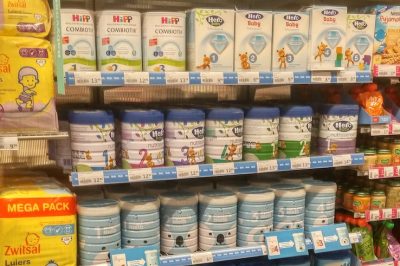Have you heard of toddler milk? The way it’s marketed may mislead parents
May 22, 2023

Infant formula and toddler milk share shelf space.
Toddler milk is an ultra-processed beverage made up of large parts powdered milk, added sugar and vegetable oil. Marketed as appropriate for kids ages 9-36 months, it contains less protein and more sodium than cow’s milk. The World Health Organization considers it unnecessary for toddler development and the American Academy of Pediatrics calls it “potentially harmful.”
With those facts in mind, it may be surprising to learn that toddler milk sales are rapidly growing around the world, especially in middle-income countries. Globally, toddler milk makes up 48% of total sales for all breast milk substitutes on the market.
The contrast in nutritional recommendations versus rising sales caught the eye of researchers at the University of North Carolina at Chapel Hill. Doctoral student Ana Paula Richter is the first author of a new paper, released May 19 by the journal Nutrition Reviews, which analyzed 45 articles about toddler milk to better understand how the product is being marketed around the world.
This is the first review to synthesize existing scientific literature around the prevalence of toddler milk use, reasons for use and how marketing trends impact consumer beliefs.

Dr. Shelley Golden

Dr. Marissa Hall
Richter, who studies health behavior at the UNC Gillings School of Global Public Health and the Carolina Population Center, worked alongside Gillings School faculty members Shelley Golden, Marissa Hall, Lindsey Smith Taillie and Deshira Wallace, as well as Gillings alum Anna Grummon, who is now at the Stanford University School of Medicine. Together with additional co-authors, they represent the fields of public health, nutrition, marketing and pediatrics.
Many parents believe toddler milk is superior to cow’s milk
The review found that toddler milk sales are largely motivated by parents’ desire to give their children the best possible shot at good health.
For example, one study of Latino parents in the United States found that the most common reasons for wanting to buy toddler milk included perceptions that it has extra nutrients (72%), supports growth (52%) and boosts brain development (41%).
A second study found that most U.S. parents perceived toddler milk to be equally healthy (38%) or healthier (44%) than cow’s milk. A third U.S. study reported that 60% of parents with children under 3 years old thought toddler milk could provide nutrition that kids do not get from other foods or beverages.
“Our review found that parents are buying toddler milk because they think it holds nutritional benefits for their children,” Richter said. “This belief is not surprising given the prevalence of marketing claims on toddler milk products about the supposed benefits. Unfortunately, these claims are generally not backed up by science.”
Parents often confuse toddler milk and infant formula

Dr. Deshira Wallace

Dr. Lindsey Smith Taillie
The researchers also found evidence that toddler milk advertising and packaging mimic infant formula products, which makes it challenging for consumers to distinguish between the two.
Multiple studies in the review suggested that this intentional cross promotion leads some parents to think toddler milk is a beneficial next step as their child weans off formula — though there is currently no evidence to support that claim. Other parents actually thought toddler milk was a variety of infant formula and could not distinguish between ads for the two products.
In reality, there are important nutritional differences between formula and toddler milk, with toddler milk generally containing greater amounts of sugar, fat and sodium (which would be especially inappropriate for an infant). Toddler milk is also more expensive than infant formula, and it receives less oversight from regulatory agencies.
The confusion between infant formula and toddler milk is problematic, says Grummon: “Our study found that the similarity of toddler milk and infant formula advertising and packaging is likely part of a strategy to circumvent laws that regulate how companies advertise infant formula.”
Toddler milk sales are increasing around the world
The 45 studies that researchers reviewed contained information on toddler milk marketing in 25 countries across six continents.
The rate of reported toddler milk consumption varied greatly depending on the location of each study. For example, one paper estimated that 11.7% of children of Chinese-born mothers had ever consumed toddler milk, while another study reported that 85.9% of urban Malaysian toddlers aged 18-24.5 months consumed toddler milk. One sample found that 40% of U.S. parents of children aged 1-5 years had ever served their child toddler milk.
All of the reviewed studies that reported on sales noted increasing sales of toddler milk over time. One study found that, globally, toddler milk sales increased 220% from 2005 to 2019.
“The increase in sales is quite dramatic and highlights a need to continue studying the impact toddler milk consumption might be having on nutritional outcomes in children,” Richter said.
Toddler milk packaging is misleading
It’s easy to see where parents are encountering convincing positive statements about the benefits of toddler milk.
Seventeen of the reviewed studies analyzed toddler milk marketing, with several reporting that advertising and packaging strategies include frequent use of health claims alongside images of happy babies. Some brands specifically reference how the product can help with toddlers’ digestion and difficulty sleeping, act as a “safety net” for picky eaters, or help children become smarter and taller.
Together, the studies suggest an urgent need for strategies to reign in unverified marketing claims.
In some countries, this could include a requirement that toddler milk products display an added sugar warning label on the front of the package. In the U.S., the Food and Drug Administration has the authority to provide food companies with guidance to ensure that labels are clear and accurate.
“Regulation might include guidelines about how companies should label toddler milk to differentiate it from infant formula and to ensure advertising does not contribute to parents’ misperceptions,” said Hall. “For example, regulators could prohibit scientifically unsubstantiated claims, which could prevent caregivers from being misled about the healthfulness of toddler milk.”
Other co-authors on this paper include Jennifer Falbe, with the Department of Human Ecology at the University of California Davis; Allison Lazard, from UNC’s Hussman School of Journalism and Media; and Jamie Conklin, at UNC’s Health Sciences Library.
Contact the UNC Gillings School of Global Public Health communications team at sphcomm@unc.edu.
